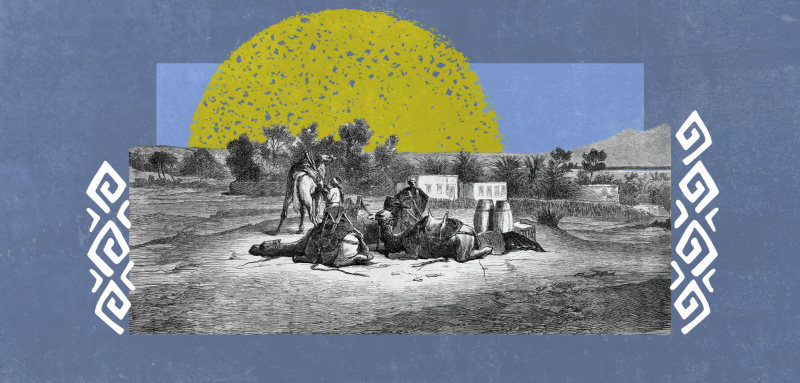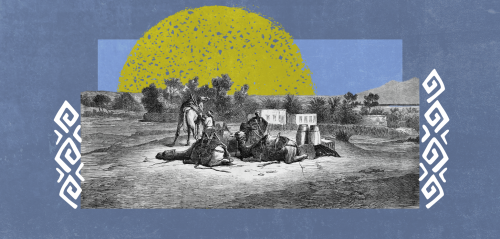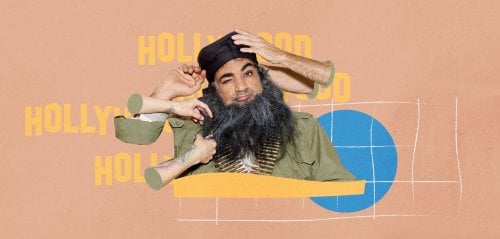The widespread notion among both researchers and non-researchers is that the Arabs were predominantly desert-dwellers or Bedouins. This perception, especially popularized by Orientalists since the 19th century, is based on the mention of the term "Arab" (عرب) in the Torah, which refers to those who inhabit the desert and engage in the breeding of camels. The same term also denoted all people residing between the Dead Sea and the Euphrates River. This historical context from the Torah strongly influenced researchers, and formed the image of Arabs that theologians transmitted to Western Orientalism.
However, historical evidence does not support the exclusive notion that Arabs solely occupied the deserts. Instead, records indicate that Arabs resided in diverse regions, including deserts, oases, between mountains, cities, and villages. The work of Greg Fisher, a researcher specializing in ancient civilizations between the two rivers, titled "Between Empires: Arabs, Roman, and Sasanians in Late Antiquity", sheds light on this multiplicity.
The historical roots of the term "Arab", its development, and its geographical scope until the emergence of Islam, remain a mystery, so numerous theories have emerged in an attempt to clarify and identify who the Arabs really were and where they lived
Despite their historical presence in ancient written sources of the ancient Near East since the 9th century BC, the Arabs did not universally identify or present themselves as Arabs across all locations in the ancient Near East. The historical roots of the term "Arab", its development, and its geographical scope until the emergence of Islam, remain a mystery. Consequently, numerous theories have arisen in an attempt to clarify and identify who the Arabs really were and where they lived.
Pre-Islamic Arabs
Who were referred to as Arabs before the advent of Islam? This question was raised by Palestinian archeology researcher at the University of Heidelberg in Germany, Mohammed Maraqten in his research titled "On the Origins of the Term Arab and Arabic". He indicated that the term "Arab" was initially employed to refer to a diverse range of individuals, tribes, and peoples, encompassing both nomads and settled communities. Its usage extended from the Arabian Peninsula to Jordan. However, over time, there was a semantic development during the 9th century BC, and the term "Arab" came to specifically denote a distinct group of people who began self-identifying as "Arabs" around the 4th century CE. Consequently, the term encompassed the inhabitants of the Arabian Peninsula, the Levant, Iraq, and Egypt.
Jacob Hoftijzer and Karl Jongeling, two researchers in Semitic languages, expounded in their work "Dictionary of the Semitic Inscriptions (2 vols)" that the etymological meaning of the word "Arab" appears in Semitic languages, particularly in inscriptions of the West Semitic languages. The root "'A r b" (ع ر ب) in Aramaic, Babylonian, Assyrian, and Hebrew in the Torah conveys the sense of "to pledge, give a guarantee, or give a deposit."
The widespread notion among both researchers and non-researchers is that Arabs were predominantly desert-dwellers or Bedouins. However, historical evidence indicate they resided in diverse regions, including deserts, oases, between mountains, and villages
Moreover, in "A Concise Dictionary of Akkadian", Jeremy Black, Andrew George, and Nicholas Postgate mentioned that the root "ʿA r b" appears in Akkadian inscriptions (erēbu) with various meanings, including "to enter". These cuneiform sources are the oldest written records referring to Arabs as a distinct human group. The term "Arab" is first recorded in the annals of the Assyrian king Shalmaneser III (859-825 BC), where he mentions an Arab chieftain named Gindibu. Gindibu participated in an alliance with the kingdoms of the Levant in the Battle of "Qarqar" against the Assyrians, leading a thousand camel-riding warriors during the battle.
This is the first mention of a specific ethnic group known as the Arabs, who dwell west of the Euphrates, mentioned as "Lū Arabāya". Following this period, they are further identified as "Arbu", "Araba", and "Aribi" in Assyrian and Babylonian cuneiform sources, indicating groups inhabiting the central Arabian Peninsula, the Syrian desert, and the borderlands between Mesopotamia and the interior regions of the Levant. This information is found in the book "The Ancient Arabs: Nomads on the Borders of the Fertile Crescent, 9th-5th Centuries B.C." by the historian and researcher, Israel Eph'al.
The two researchers persistently sought to ascertain the origins of the term "Arab" in all ancient written sources. In the dictionary "Hebräisches und Aramäisches Lexikon zum Alten Testament" (A Concise Hebrew and Aramaic Lexicon of the Old Testament), Ludwig Köhler and Walter Baumgartner noted that the root of the word "Arab" appears in the Old Testament, bearing the meaning "to enter" or "west," frequently associated with the desert Bedouins inhabiting the Syrian desert and other regions of Palestine and northern Arabia.
Researchers indicate the term "Arab" was initially used to refer to a diverse range of tribes and peoples including both nomads and settled communities from the Arabian Peninsula to Jordan, but later covered inhabitants of the Levant, Iraq, and Egypt as well
They are the one who speak Arabic
The theory that Arabs are defined by their proficiency in the Arabic language emerged under the influence of modern nationalist ideologies, suggesting that the Arab identity of a region is determined by the presence of Arabic speakers. This notion, as highlighted by researcher Mohammed Maraqten in his earlier study, contrasts with another theory that identifies Arabs as a class of knights and warriors. In his book "The Arabs in Antiquity: Their History from the Assyrians to the Umayyads", Jan Retsö argues that Arabs were not exclusively desert dwellers or Bedouins but also served as knights and warriors during the Byzantine Empire. He proposes that the term "Arab" means "army", and their role involved guarding and patrolling urban areas.
As for Austrian orientalist Gustave von Grunebaum, he suggests that Arabs form a distinct human group with diverse social, economic, and political practices, saying they form a cultural entity with shared ties, and constitute themselves as a nation. However, Palestinian researcher Mohammed Maraqten argues that it is hard to impose modern national and ethnic definitions on ancient peoples. The term "Arabs" can be seen as a general descriptor applied to a group of people and tribes linked by linguistic, cultural, religious, legal, and geographic connections, ranging from Najran to Palmyra. This designation first appeared in the mid-19th century BC and has been explicitly used to refer to Arabs since the 4th century AD and up to the present day.
Solely linking Arabs to the desert is inaccurate, as their presence extended beyond Bedouin communities and the desert. They were present in many other regions, but they remained united by a shared culture, lifestyle, and a common language with many dialects
The language spoken by the Arabs
Wolf Dietrich Fisch, in his book "Studies in Arabic: Its Origins and Historical Stages", notes that our knowledge of the early history of the Arabic language is derived from ancient Arabic inscriptions, such as the "Safaitic" and "Sabaic" (or "Sabaean") inscriptions found across the Arabian Peninsula from pre-Islamic times. While the origin of the Arabic language remains unknown, its widespread use can be traced back to the 9th century BC, spreading across vast regions from Yemen in the south to Euphrates in the north.
The linguistic map of the Arabian Peninsula appears to have been unified since the 3rd millennium BC. However, linguistic evidence from the 3rd and 2nd millennia BC remains scarce. The study presented by Michael C. A. MacDonald on the linguistic map of the Arabian Peninsula primarily relies on font patterns rather than linguistic chracteristics, as discussed in his book "Reflections on the Linguistic Map of Pre-Islamic Arabia".
It is worth mentioning that a group of ancient, pre-classical Arabic inscriptions, predating Classical Arabic, have been discovered, such as the "Umm el-Jimal" inscription dating back to 250-270 AD, and the second "Umm el-Jimal" inscription dating back to the 5th and 6th centuries AD in Jordan. Two more inscriptions were discovered in Sakaka, northwestern Saudi Arabia, with the first dating back to the 4th and 5th centuries AD, and the second to the 5th and 6th centuries AD, as explained by archaeologist Robert G. Hoyland in his book "Epigraphy and the Emergence of Arab Identity." It becomes evident that solely linking Arabs to the desert is inaccurate, as their presence extended beyond Bedouin communities and the desert. They were present in many other regions, and despite their diversity, they remained united by a shared culture, lifestyle, and possibly a common language with diverse dialects.
Raseef22 is a not for profit entity. Our focus is on quality journalism. Every contribution to the NasRaseef membership goes directly towards journalism production. We stand independent, not accepting corporate sponsorships, sponsored content or political funding.
Support our mission to keep Raseef22 available to all readers by clicking here!
Interested in writing with us? Check our pitch process here!








